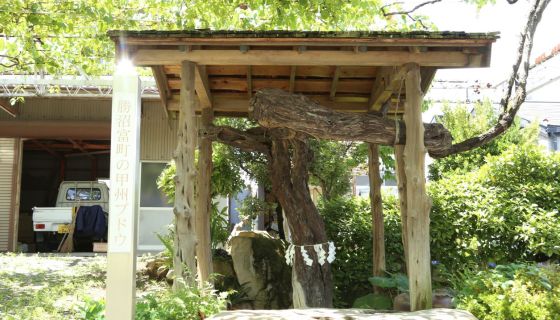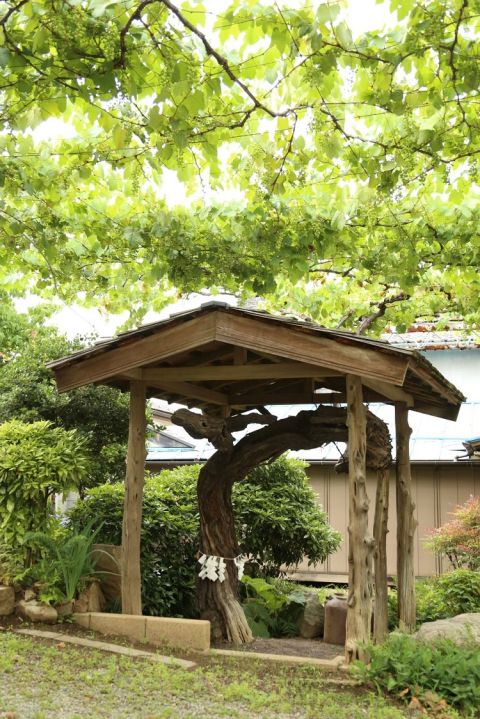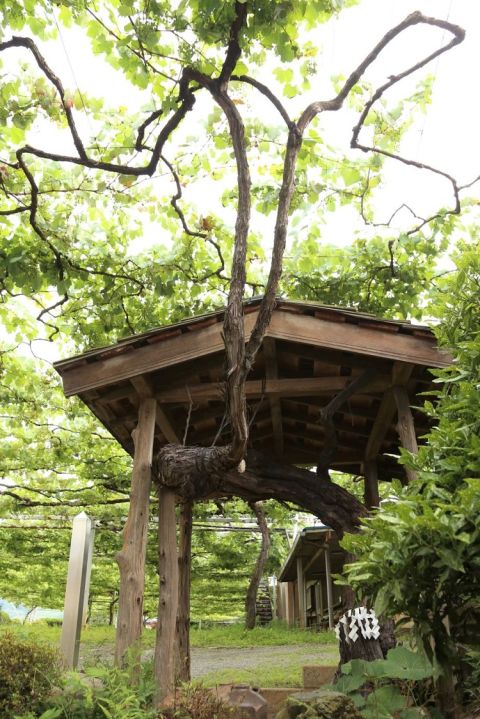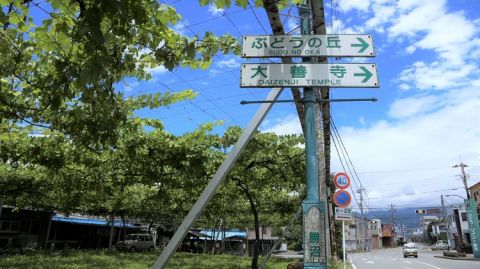This was one of the greatest roads in Japan, you know. The Koshu Kaido. I can still hear the braying of the horses tied up in front of the inns. The farmers use kei trucks to carry their crates of grapes nowadays rather than wooden poles over their shoulders, but otherwise things change slowly around here and that’s the way I like it.
My name is Koryu and I am 123 years old. I’m the oldest grapevine in Japan, you know, but what I’m really proud of is that I’ve now lived longer than any human in the world. The ‘Ko’ in my name is the first character of Koshu, for I’m a Koshu vine, and ‘ryu’ means dragon. My trunk is all sinuous like those dragons in 16th Century ink paintings. I’m a little thick around the midriff now, but the older I get the scalier and greyer I become. Secretly I rather like it. Gives me presence I feel. No, ‘gravitas’, that’s the word! When I was registered as a Designated Cultural Property in the 70’s they built this little shrine for me too, and put shide paper around my trunk to ward off bad spirits. It looks rather dignified, if I do say so myself.
Where was I? Alas my talons, so to speak, don’t reach as far as they once did, but I manage to maintain a canopy with enough grapes for a barrel of wine. In my prime, I used to stretch past the outbuildings to take in the view of the Kofu basin and the snow-capped Japanese Alps beyond. They call this the Koshu Valley now, but back when the valley was just a collection of villages, I didn’t need to share the vineyard with all these young vines. I don’t begrudge the company though. With different characters, my name would mean ‘mingling’, and mingle I have over the years.
When I was planted at the end of the 19th Century, my social network was limited to my owners and the neighbours. Then the tourists came. It was probably that set of promotional woodblock prints that did it. They have one on display at the museum, folk sitting under the vines with Mt. Fuji in the background. So this overhead trellising – tanashiki we call it – was replaced with a higher pergola for picnicking. I can still feel the barbecue smoke wafting up. It probably helped keep the bugs off me come to think of it.
In the early days, visiting Tokyoites used to eat my grapes, bitter seeds and all. They were an exotic treat – try telling that to kids nowadays! The fruits of our labours were sent to the Imperial Household for entertaining and shipped to troops to cheer them up. But to us locals they were normal. ‘Even the packhorse drivers eat grapes in Katsunuma’ as the poem goes. They say it was written by Matsuo Bashō in the 17th Century, but I’m not completely convinced. Engrave it on a stone and it must be true! And they say PR is a modern invention.
We Koshus are all born and brought up here, apart from that one that emigrated to Germany. But the new generation of vines are to me a different breed. It’s all more, more, more. Brighter colour, higher sugar content, larger yields. I can’t keep up. Perhaps I’m showing my age, but ‘KW05’? That’s not a name! There aren’t many of my stock anymore. My grapes are a lighter shade of the dusky pink, you see, and my bunches are particularly long. ‘Spindly’, some of the young ‘uns say. Anyway, these days vines are engineered in university labs and grafted. Labs, I tell you! The mind boggles. I’ve got ‘clones’ now, you know. That took a bit of getting used to.
I tell you, this new generation of vines are so sensitive and high maintenance. The farmers have to knock ‘em down a branch or two when they’re young to toughen them up. There was no need for boot camp in my day. You were popped in the ground and it was survival of the fittest. ‘Developed for resilience’, humph! We learnt it the hard way. Today the young vines are more interested in wearing the latest hats and having their photos taken. We didn’t need hats. Rain, spores, we just got on with it.
Ah, those young vines do wind me up. You know, one of them called us old Koshus ‘acerbic’ the other day. Even at my age that hurt. We may have thick skins us Koshus, but we are delicate souls inside. Some say my bitterness makes me harder to work with than the youngsters, but I can only hope their focus on ‘individuality’ works out for them. They’ll soon learn it’s a delicate balancing act being unique yet expecting everyone to understand you.
I try to be open-minded. It can’t be easy for the young ones. It has become much hotter over the last century for a start. The sasago oroshi breeze brings less relief than it once did. And there is such competition now. For centuries, we Koshus were the only grapes in Japan. Had the place to ourselves until the end of the Edo Period they say, so that’s 1868. Nowadays we have to compete with all those charismatic Chardonnays and Petit Verdots, and there’s no room to show weakness. We pass our prime around 30, you see, and the moment you look down to find the farmer’s planted a young vine near you is the moment you know you only have a few years left. So I’m very fortunate.
What would our founding father think of all this change, I often wonder? Not that the young vines believe in him anymore. Some say he flew here from China with the birds, some say he came on a boat with a Buddhist monk. Either way he was a healer. Thousands of priests flocked to Daizenji Temple in the 8th Century to tend his medicinal vines. His ancestors are still there today, and that includes me by extension. They say he arrived in 718 but I don’t know how they can be so precise – they can’t even remember exactly when they planted me! If you climbed up my trellis, you’d see Daizenji up there on the hillside. The head priest still makes wine.
My owners aren’t winemakers themselves, in case you’re wondering. That’s generally the way it works around here, especially after the war when they split up the samurai estates. And it’s a blessing to be honest, otherwise I’d be lost in some huge field with no people nearby. I like people-watching on the crossroads here, and if anyone tries to steal my grapes there’s the koban police box just across the road. My owners sell my grapes to a winery down the road called ‘Huggy’. That’s English I think, after the owner Hagihara-san. My wine’s sold for over six thousand yen a bottle! That’s some of the most expensive Koshu there is, I’ll have you know.
In the old days, Koshu was a sweet wine, which I rather liked – it improves with age, like the best of us – but they say they just added sugar to hide the difficulties of getting flavour from our delicate juices. They apparently only crushed leftover table grapes back then, but nowadays no-one eats Koshu grapes because they can have those juicy fujiminori the size of plums instead.
So winemakers get the best of us and they’ve come a long way since those two chaps were sent to France in 1877. That was before my time, but from what I hear they didn’t learn much that could be put into practice in the humid climate here. I’ve my own opinion on that of course. Look, they sent two young men on their own, from a country that had been shut off from the world for 250 years, to Champagne for goodness’ sake. How on earth did they expect them to concentrate!
Nowadays there’s sur lie, malolactic fermentation, so-called ‘orange’ wine, and sparkling. Call me old fashioned, but I personally think simple is best. We should be proud of our subtleties. I’ve been alive for 123 years and still no-one understands me! That said, it’s all about noise-cancelling headphones and meditation these days, so I think people will eventually see the light. You know deep down you’d prefer a glass of wine with your sushi than sake. Those rice paddies plead ignorance when people continue to call their sake ‘Japanese wine’, but I know what they’re up to! I suppose I shouldn’t complain – I’m only here because the area wasn’t well suited to rice-growing.
Here come my owners in the car. I still remember the first time I saw a car. It was when Emperor Showa came the first time, when he was still Crown Prince. They drove down the hill and he sat under the vines across the river. It’s funny seeing all the staged photos of women picking grapes in kimono – as if you’d harvest grapes in your best kimono! Ah, the responsibilities of curating history. I’m glad I’m just a bystander.
The photos are provided by Rosemary Mitchell.



















